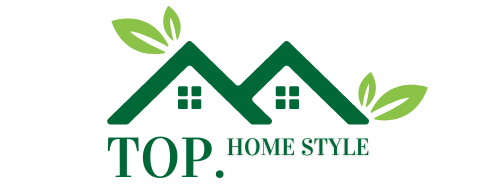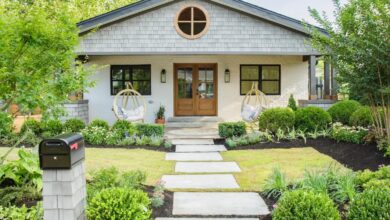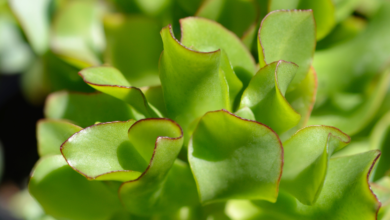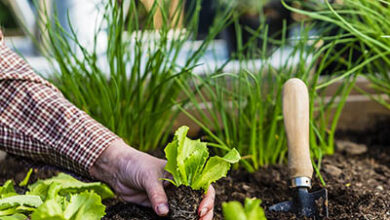It’s easy to grow an abundant cucumber harvest with just a few healthy plants. Having extra cucumbers isn’t a problem if you have chickens as they will devour a chilled cucumber on a hot summer day in no time.
Cucumber plants are vining and will quickly take over the garden if you let them. I grow cucumbers on a trellis to keep them up off the ground.
Cucumbers are similar to tomatoes in that they don’t like cold temperatures. Start seeds indoors 3-4 weeks before the first frost date.
Cucumber seeds sprout quickly. Make sure their garden plot is ready shortly after starting them indoors.
Cucumbers have a high water content which means they need quite a bit of water throughout the growing season. Place cucumber plants in full-sun with well-draining soil and water them every day.
As my cucumber plants grow more leaves, I simply weave their vines up a trellis. In a few short weeks, I have more cucumbers than I know what to do with.
Pumpkins and Winter Squash
Squash are perfect for beginner gardening too. Pumpkins are a type of winter squash that will vine their way through the garden, so be sure to give them lots of space. Other common varieties of winter squash that are easy to grow include:
- Butternut squash
- Spaghetti squash
- Acorn squash
These are all the types of squash that become popular in the fall because they have a longer growing season than summer squash.
There are many ways to preserve winter squash for months so that your family can enjoy the flavors of these fresh vegetables in the dead of winter when fresh and local produce is scarce.
Winter squash varieties (including pumpkins) are also easy to grow—especially in areas with longer summers.
Plant winter squash seeds in the ground following the last frost date or begin seeds indoors 2-4 weeks before that date for a quicker harvest as it can take 70-100 days for the vegetables to become fully ripe.
Grow winter squash on hills or mounds and make sure the soil drains well. Winter squash prefers slow, deep watering at the root level. A soaker hose is a good investment if you’d like to plant many varieties of winter squash in your garden.
Zucchini and Summer Squash
Zucchini is a type of summer squash that tastes excellent in stir fry, summer vegetable salads, and even baked goods.
Like cucumbers, you can quickly grow more zucchini than you need with just a couple of plants. Besides zucchini, common varieties of summer squash include:
- Cousa
- Crookneck
- Yellow Squash
- Pattypan
Zucchini and summer squash can either be vining or a bush variety. They all tend to grow best in consistently moist soil (another use for a soaker hose) and full-sun.
The bush varieties are perfect for small garden spaces and will even work in a container garden for apartment homesteaders.
Summer squash can be planted indoors before the last frost date or sown directly in the ground after that date.
These plants are less hardy than their winter counterparts and won’t tolerate frost. Space your plants about a foot apart to leave plenty of room for their broad leaves to stretch out.
Squash varieties often attract a notoriously hungry pest known as the squash bug. These pesky insects will lay eggs on the bottom side of squash leaves, and before you know it, the eggs will hatch, and the pests will devour your plants.
If you wish to grow any type of squash in your garden, prepare a natural pesticide like this neem oil spray to prevent these bugs from ruining your harvest. However, with squash bugs, I’ve found picking them off by hand is the best defense.
Peppers
With so many different varieties, shapes, and colors, peppers are a joy to grow! They don’t require a large amount of space, making them perfect for growing in a small bed or container. Some common pepper varieties to grow in the garden include:
- Bell pepper
- Poblano pepper
- Cayenne
- Jalapeno
Peppers grow best in warmer temperatures, so for an earlier harvest, it is a good idea to start seeds indoors 2-4 weeks before the last frost date. Once daytime temperatures have warmed to mid to upper-60s, it is safe to plant peppers in the garden.
Mulching around the base of your pepper plants will help the ground stay cool and moist throughout the summer. Pepper plants will do best in full sun and with about 1-2 inches of water each week.
Once your pepper plants are established, place a stake or small tomato cage over them to support the peppers once they begin to develop.
Carrots
Carrots are great for beginner gardening because they are so easy to maintain. Plus, carrots do well in container gardens as long as they are deep enough.
Carrot seeds are tiny and should be sown directly into the garden for early spring and late fall harvests. Carrots prefer cooler temperatures and loose, nutrient-dense soil.
I spread carrot seeds across rows about a foot apart to give them enough space, but not too much that I’d need to worry about weeding a big area. Weeds around carrots will draw nutrients from the soil and crowd the tender roots.
Carrots need a deep watering to encourage their roots to grow. A soaker hose is useful to get water directly at the roots giving them a thorough soaking every one to two days.
To check on the size of your carrots, simply scrape a little dirt at the base of your plant away to see how fat they are. In 6-8 weeks after planting, your carrots should be ready for harvesting. Gently dig up the carrots and marvel at the different shapes and sizes you find!
Peas
I love growing peas because they are often the first vegetable ready for harvest in my garden each spring (and I’m dying for fresh, homegrown veggies by then!). Their bright green color spiraling up a trellis is a refreshing sight after a long winter. They are perfect for beginner gardening.
About 4-6 weeks before the last frost date in your area, plant pea seeds directly in the garden. For a fall harvest, sow pea seeds 6-8 weeks before the first fall frost.
Pea plants grow best in slightly drier soil. If your garden tends to collect water in the spring, you may want to grow peas in a container or raised bed. Water pea plants every other day or when you notice the soil is mostly dry.
Pea plants are fragile. Pull any weeds up by hand rather than using a tiller or weeding device that may go too deep and cut the roots (or use deep mulch as I do). The more you pick the pea pods from the plant, the more you will encourage new ones to grow.
Beets
I didn’t include beets in my garden at first because I didn’t know they were so easy to grow. Like peas, beets are a cool-season crop with nutritious roots and leafy greens.
Beets are fast growers in loose, well-draining soil. They prefer a sunny spot in the garden. Sow seeds in rows in early spring, and then again in late summer. Keep the soil moist by mulching around the plants. Avoid damaging the tender roots by pulling weeds by hand.
Beets will be ready to harvest within 50-70 days of planting. Gently pull the beetroots out of the ground and shake them free of any loose dirt.
I’ve found that fresh beets will keep longer in the refrigerator if I clip the greens off and store them separately.
Onions
Onions are another staple in our house. I add chopped and sliced onions to just about every soup or salad I make.
Onions have a long growing season and are typically harvested in the fall. Like other root vegetables, onions need loose, well-draining soil.
You can choose to start onions from seed or a starter bulb set. I start onions from a bulb set because that method has been more successful for me.
Adding compost between onion rows helps keep the ground both moist and loose around the bulbs.
When the onion tops have dried and fallen limp, you know they are ready to be harvested. Gently loosen the soil from around the bulb heads and pull them out of the ground. Late summer or early fall is best for collecting onions as colder temperatures can cause onions to rot.
Green Beans or Pole Beans
Green beans and pole beans are a kid favorite in our family. They love to eat them raw out of the garden! They will also occasionally eat them cooked. Green beans grow quickly, so they are a great plant for a fall garden or to fill in spaces where other plants didn’t survive.Green beans can be started indoors or direct sowed outdoors after the risk of frost.They like full sun and plenty of water throughout the growing season. Pole beans will need a trellis or other support as they grow while bush beans need little care.Wait until the beans are firm and snap when harvested but before you can see the seeds inside bulging. Harvest green beans by snapping the beans from the plant. The more you pick, the more the plant will produce, so get outside every 2 days to collect beans.
There are many vegetables that a beginner gardener could start growing, but I’ve found these have been the simplest plants to include in a vegetable garden. They provide lots of nutrients and are easy to add to a variety of dishes.
How Do You Start a Garden?
You now know which vegetables to plant for beginner gardening to master the basics of organic gardening. Use these general gardening tips to get yourself started on the right foot.
When Should You Start a Garden?
Most gardeners will begin seeds indoors anywhere from 6-8 weeks before the last frost date. This gives seedlings time to establish a healthy set of roots before being planted in the garden.
It’s also a good idea to give your seedlings time to adjust to outdoor conditions like wind, rain, and direct sunlight before planting them in the garden. A few weeks before transplanting your seedlings, bring them outside for a few hours at a time to ‘harden them off.’
This is a gardening term that means you are preparing the seedlings for the outdoor conditions that they will be growing in for the remainder of the year.
Search the Farmer’s Almanac website to find out when the last frost date is predicted for your area. You can also begin a garden in the mid to late summer for a fall harvest.
What Do You Need to Start a Garden?
You don’t need a large plot of land or heavy equipment to start a simple vegetable garden. Beginners can have a successful garden with:
- A few packets of seeds
- A small plot of land
- A couple of shovels
- A hoe and rake
- A watering can or hose
If you don’t have any growing space, consider starting a container garden, or find out if there is a community garden nearby.




